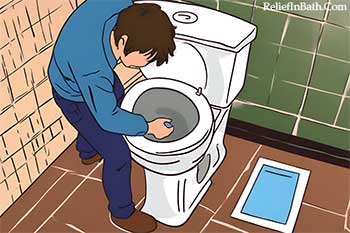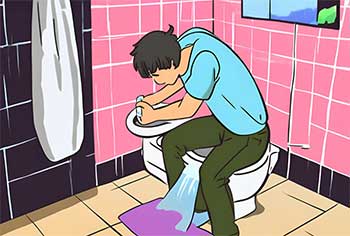We’ve all been there.
You’re standing over the toilet, something in hand, and you hesitate for a moment. Can I flush this? It seems so convenient to just send it down, out of sight and out of mind.
But is it really okay to flush?
The answer, surprisingly, is usually no. Today, we’re going to dive into the nitty-gritty of toilet etiquette and discover why you should only flush three things down the toilet: pee, poo, and paper.
Yes, just those three. Stick with me, and I’ll explain why.
Why Flushing Right Matters?

Before we get into the specifics of what you should flush, let’s talk about why it matters.
Toilets and sewer systems are designed to handle very specific types of waste.
Flushing the wrong items can lead to serious plumbing issues, environmental problems, and hefty repair bills.
Not to mention the inconvenience of a clogged toilet. I know, it’s not glamorous, but understanding this can save you a lot of trouble in the long run.
The Big Three: Pee, Poo, and Paper
Let’s break down the only three things you should ever flush:
- Pee: This one’s pretty straightforward. Urine is liquid waste, and toilets are specifically designed to handle liquids. No problems here.
- Poo: Feces are another type of waste that toilets are built to dispose of efficiently. Modern sewage systems can handle solid waste, so long as it’s the right kind.
- Paper: Here, we’re talking specifically about toilet paper. Not just any paper, but toilet paper that’s designed to dissolve quickly in water, preventing clogs and ensuring smooth passage through the sewage system.
What Happens When You Flush the Wrong Things?
Imagine flushing something that doesn’t belong. It might seem harmless at first, but here’s what really happens. Non-flushable items don’t break down easily.
They can get stuck in your pipes, leading to blockages. These blockages can cause your toilet to back up, which is both a mess and a health hazard. And if it gets into the sewer system, it can create bigger problems, like clogged sewer lines and even environmental contamination.
Common Misconceptions: Things You Should Never Flush
Many items that seem flushable are actually not. Let’s go over some of the most common offenders:
- Wipes (Even “Flushable” Ones): Despite the label, “flushable” wipes don’t break down like toilet paper. They stay intact much longer and can cause serious blockages.
- Sanitary Products: Tampons, pads, and other sanitary products don’t disintegrate in water. They expand and can easily clog pipes.
- Paper Towels and Tissues: These are designed to be durable, which means they don’t break down quickly in water. They can cause clogs just as easily as wipes and sanitary products.
- Cotton Balls and Q-Tips: Cotton doesn’t dissolve in water. These items can clump together and create blockages.
- Hair: Hair can tangle and form clogs, especially when combined with other substances.
- Medication: Flushing medication can introduce harmful chemicals into the water supply. It’s better to dispose of these through proper medical disposal methods.
The Environmental Impact
It’s not just about your plumbing. When you flush the wrong things, it can have a broader environmental impact. Non-biodegradable materials can end up in waterways, harming wildlife and contaminating ecosystems.
Wastewater treatment plants aren’t designed to filter out all these materials, which means they can end up in rivers, lakes, and oceans. By sticking to the Big Three, you’re doing your part to protect the environment.
How To Dispose of Non-Flushables?
So, if you can’t flush these items, what should you do with them? Here’s a quick guide:
- Wipes and Sanitary Products: Wrap them up and throw them in the trash. It’s simple and effective.
- Paper Towels and Tissues: These belong in the garbage, too. They’re too tough for your pipes to handle.
- Cotton Balls, Q-Tips, and Hair: These should also go in the trash.
- Medication: Many pharmacies offer take-back programs where you can return unused or expired medications. Alternatively, look for local hazardous waste disposal programs.
Making It A Habit
Changing your habits can be tough, but it’s worth it. Here are some tips to help you remember:
- Keep a Trash Can Nearby: Make sure there’s a trash can within arm’s reach of your toilet. This way, you won’t be tempted to flush something you shouldn’t.
- Educate Your Household: Make sure everyone in your home knows what’s flushable and what’s not. It’s a team effort!
- Post a Reminder: A small sign near the toilet can remind you and your guests of the Big Three.
Common Myths Debunked
Let’s tackle some common myths about flushing:

- “If it fits, it’s fine.”: Not true! Just because something can go down the toilet doesn’t mean it should. The size isn’t the issue – it’s how the item breaks down (or doesn’t).
- “Flushable wipes are safe.”: We’ve covered this, but it’s worth repeating. Flushable wipes aren’t really flushable in the sense we need them to be. They cause clogs and environmental damage.
- “Toilet paper alternatives are okay.”: Items like paper towels, tissues, and even some “eco-friendly” products don’t break down like toilet paper. Stick to products specifically designed for the toilet.
A Quick Recap
To sum it up, only three things belong in your toilet: pee, poo, and toilet paper. Everything else should go in the trash or be disposed of through proper channels. By following this simple rule, you can avoid plumbing problems, save money on repairs, and help protect the environment.
Making The World A Better Place, One Flush At A Time
You might think that one person’s habits don’t make much of a difference, but they do. Imagine if everyone only flushed what they should. We’d have fewer plumbing issues, less environmental damage, and cleaner water systems. It all starts with you – one flush at a time.
So, next time you’re tempted to flush something questionable, remember: pee, poo, and paper. Keep it simple, keep it clean, and keep your plumbing happy.
Final Thoughts
Flushing only pee, poo, and paper might seem like a small act, but it has big implications. By sticking to these three things, you’re not just protecting your plumbing and saving money – you’re also helping to protect our environment.
It’s a small change with a big impact. So, let’s all make a pledge to flush responsibly. Trust me, your pipes (and the planet) will thank you!
